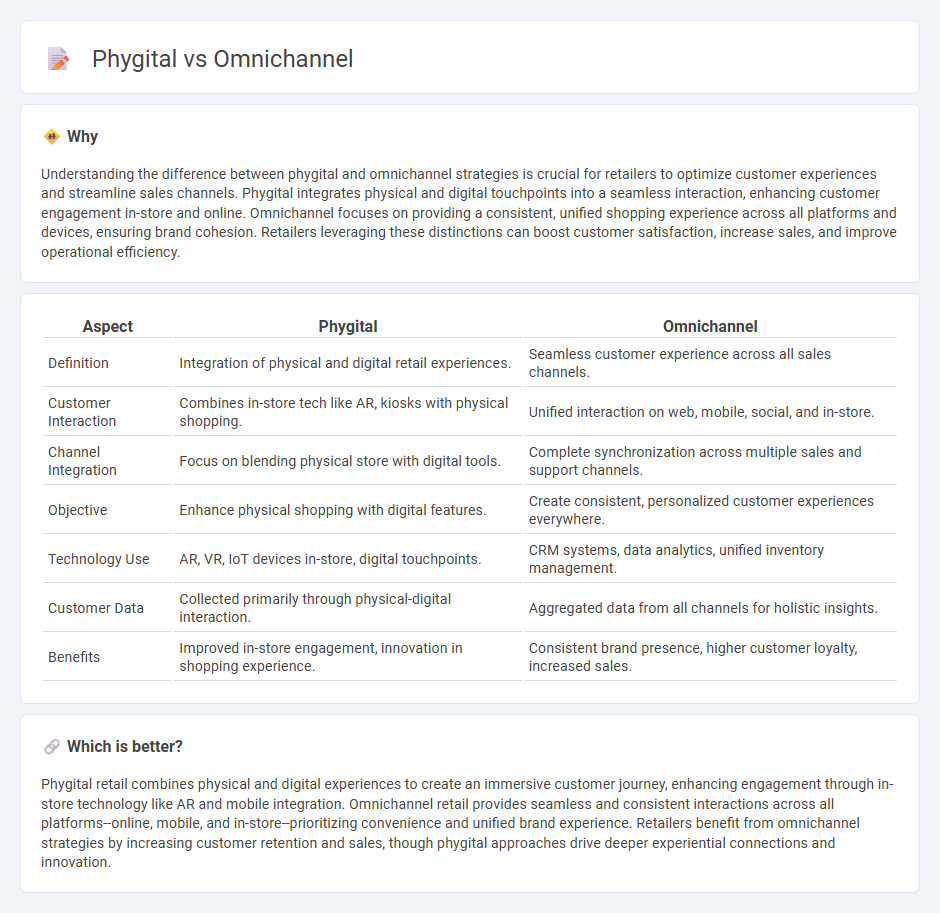
Phygital retail blends physical and digital experiences to create seamless customer interactions, integrating in-store technology with online platforms for enhanced engagement. Omnichannel retail focuses on providing a unified shopping journey across all channels, ensuring consistency in product availability, pricing, and customer service whether online, mobile, or brick-and-mortar. Explore how phygital and omnichannel strategies are transforming the future of retail.
Why it is important
Understanding the difference between phygital and omnichannel strategies is crucial for retailers to optimize customer experiences and streamline sales channels. Phygital integrates physical and digital touchpoints into a seamless interaction, enhancing customer engagement in-store and online. Omnichannel focuses on providing a consistent, unified shopping experience across all platforms and devices, ensuring brand cohesion. Retailers leveraging these distinctions can boost customer satisfaction, increase sales, and improve operational efficiency.
Comparison Table
| Aspect | Phygital | Omnichannel |
|---|---|---|
| Definition | Integration of physical and digital retail experiences. | Seamless customer experience across all sales channels. |
| Customer Interaction | Combines in-store tech like AR, kiosks with physical shopping. | Unified interaction on web, mobile, social, and in-store. |
| Channel Integration | Focus on blending physical store with digital tools. | Complete synchronization across multiple sales and support channels. |
| Objective | Enhance physical shopping with digital features. | Create consistent, personalized customer experiences everywhere. |
| Technology Use | AR, VR, IoT devices in-store, digital touchpoints. | CRM systems, data analytics, unified inventory management. |
| Customer Data | Collected primarily through physical-digital interaction. | Aggregated data from all channels for holistic insights. |
| Benefits | Improved in-store engagement, innovation in shopping experience. | Consistent brand presence, higher customer loyalty, increased sales. |
Which is better?
Phygital retail combines physical and digital experiences to create an immersive customer journey, enhancing engagement through in-store technology like AR and mobile integration. Omnichannel retail provides seamless and consistent interactions across all platforms--online, mobile, and in-store--prioritizing convenience and unified brand experience. Retailers benefit from omnichannel strategies by increasing customer retention and sales, though phygital approaches drive deeper experiential connections and innovation.
Connection
Phygital retail integrates physical and digital shopping experiences, creating a seamless customer journey that enhances engagement and convenience. Omnichannel strategies further support this integration by synchronizing multiple touchpoints--online, mobile, and in-store--ensuring consistent branding and inventory visibility. Together, phygital and omnichannel approaches drive higher customer satisfaction and increased sales by bridging the gap between digital innovation and traditional retail environments.
Key Terms
Customer Experience
Omnichannel integrates multiple digital and physical channels to provide customers with a seamless and consistent experience across platforms, enhancing engagement and satisfaction by allowing fluid transitions between online and offline touchpoints. Phygital combines physical and digital interactions in real-time, creating immersive, interactive environments that personalize customer experiences and drive higher emotional connection through technology like AR, VR, and smart devices. Explore the nuances between omnichannel and phygital strategies to elevate your customer experience and stay ahead in competitive markets.
Channel Integration
Omnichannel strategies seamlessly integrate multiple digital and physical channels to provide a unified customer experience across touchpoints such as online stores, mobile apps, social media, and brick-and-mortar locations. Phygital focuses on blending physical and digital interactions within the same environment, enhancing customer engagement through technologies like augmented reality and interactive kiosks. Explore how channel integration drives customer satisfaction and operational efficiency in both omnichannel and phygital models.
Digital-Physical Interaction
Omnichannel integrates multiple digital and physical customer touchpoints into a seamless experience, leveraging technologies like mobile apps, social media, and in-store kiosks to ensure consistent brand interaction. Phygital emphasizes the fusion of physical and digital elements within a single experience, such as augmented reality fitting rooms or smart shelves, enhancing real-time engagement and personalization. Explore our detailed analysis to understand how these strategies transform customer interaction and drive business growth.
Source and External Links
Omnichannel - Omnichannel is a business strategy defined as seamless and effortless, high-quality integration across all channels to provide a unified customer experience.
Learn about omnichannel marketing and how to develop a ... - Omnichannel marketing prioritizes the customer experience across all channels by integrating online and offline touchpoints into a seamless journey with consistent messaging, unlike multichannel marketing which focuses on separate channels.
What is Omnichannel? - An omnichannel approach provides a unified, seamless customer journey allowing customers to switch between communication channels without interruption or repeated information, increasing customer retention and loyalty.
 dowidth.com
dowidth.com